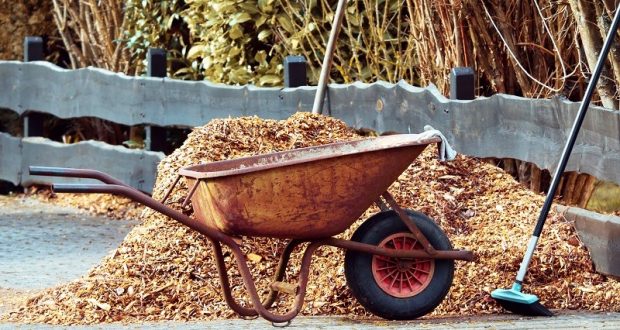By Brian David, UC Master Gardener, Mariposa
California’s winter rains patter on fallen leaves and brown grasses above soils crawling with sub-terrestrial animals. Natural mulch feeds a crescendo of green emerging to meet the sky. Mulching is a cycle of plants and trees laying down their old lives to produce the earth’s new life. When we spread organic matter over our soil, we are mimicking our planet’s natural ecology.
Because we can recombine elements, we can also spread manufactured materials like polyethylene plastics or woven ground cloth, over the soil to influence the growth and character of plants.
Polyethylene plastic can warm soil two inches below its surface by five degrees. Black polyethylene plastic lies over strawberry rows off Highway 140, between Planada and Merced. Depending on the color, plastics can be used to warm or cool soil temperatures. Black plastic mulch will stop weeds and increase soil moisture. White, yellow, orange, blue, striped and metallic plastics all have their color specific roles. Plastic mulches can affect soil and crop characteristics from inhibiting soil pathogens to enhancing plant photosynthesis.
Earth-produced mulches like wood chips, straw, almond hulls, all kinds of dried plant material, including grass cuttings, are used as a natural garden mulches. The ideal method of mulching includes: (1) leveling your planting area, (2) lightly turning compost or soil amendments into your soil and, (3) laying two to twelve inches of mulch on top of your prepared soil.
An organic mulch will eventually be transformed into compost, feeding the soil and plants. For coarse material the process may take a few years. But nutrients, like nitrogen, will be released into the soil, feeding good micro-organisms and improving the soil’s structure.
A good deep mulch will distribute moisture, reduce soil evaporation by 35%, regulate temperature changes, reduce soil compaction, increase soil aeration and water holding capacity, increase crop yield, allow crops to mature earlier, improve crop health and quality, keep negative organisms in check, reduce salts in the soil and help mend pesticide damaged soils.
There are a few mulching draw backs. Mulch may hold too much water, inviting snails and sow bugs. This often happens with lawn clippings, because the particles are too fine and compacted. If the mulch is not well dried prior to covering your soil it can transfer whatever diseases the mulched plant had; this is a major problem when using ground tree roots.
Mulches that cover the crown or tree trunk can harm a tree. Mulch touching the stem of a plant may cause plant damage. So several inches should be kept around the tree trunk or plant stem. Dry flammable materials like shredded bark or wood chips near a house or structure can keep smoldering embers alive for days. So dry plant-based mulches like wood chips should be several yards from your house or structure.
Do you have your garden covered? Mulches are something every gardener can experiment with. Mulching’s potential benefits are worth the time and investment. May you become an undercover gardener in 2020.
UC Master Gardeners of Mariposa County are located at 5009 Fairgrounds Rd., Mariposa. For more gardening and event information, visit our website (http://cemariposa.ucanr.edu/Master_Gardener/) and Facebook page (UC Master Gardeners of Mariposa County). UC Master Gardeners staff a Helpline serving Mariposa County, including Greeley Hill, Coulterville, and Lake Don Pedro (209-966-7078 or mgmariposa@ucdavis.edu). Listen to us on the radio at KRYZ 98.5 FM on Wednesdays at 2 p.m. and Saturdays at 5 p.m.




